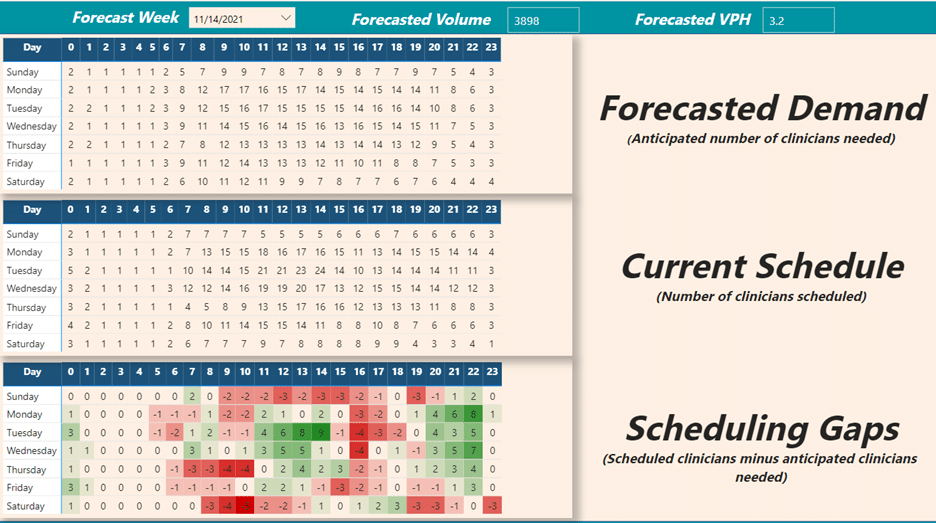CASE STUDY
Demand Forecasting and Capacity Planning with Power BI boosts Telehealth revenue
KEY OUTCOME
Discover how having the right Demand forecasting and Capacity planning tool can help and how Data Ideology can be the solution.
How did Data Ideology solve this organization’s challenges?
CHALLENGE SUMMARY
An e-commerce fulfillment organization was in serious need of a modern data visualization tool to gain valuable insights into their operation. Heavy reliance on static reports with no self-service capabilities left both IT and business groups unhappy. With the holiday season on the horizon, there were less than 90 days to scale a BI solution.
SOLUTION SUMMARY
Accelerate the Tableau adoption by engaging stakeholders with beta testing and customized training for better understanding of the BI tool’s capabilities while increasing self-service capabilities and streamlining data processes.
GOING DEEPER ON THEIR CHALLENGE
For many organizations, having the necessary staff to support customer demand is a critical element for both short & long-term success. Having the ability to produce demand forecasting and capacity planning reports are vital for resource planning.
As an example, one of our Healthcare clients asked us to help them address a potential imbalance between the demand that they were seeing in their Telehealth division, compared to the clinicians that were staffed to support that demand.
In the current state, Telehealth management had done all of their demand and capacity reporting on an ad hoc basis, exporting data from multiple systems and cobbling Excel spreadsheet together. Upon hearing this information, our team of experts explained how a tool such as Power BI has the functionality to generate accurate Demand Forecasting and Capacity Planning reports that can identify gaps to help reallocate labor resources and improve utilization rates.
UNDERSTANDING DATA IDEOLOGY’S SOLUTION
How did we use Power BI to create a Demand & Capacity forecasting report to solve this issue?
Due to Power BI’s ability to unify multiple data sources and model them together, we accessed the historic Telehealth visit data and married it with the clinician’s scheduling system. Once the numerous variables were merged, we developed and followed these steps to build out the analysis:
Analyze the time of day and day of week in which visits were typically occurring. We used a trailing six-week average as our baseline.
Reference the scheduling system data to determine when clinicians were scheduled to work in the coming weeks.
Utilize a baseline visits-per-hour metric and multiplied by the number of clinicians scheduled to forecast how many potential visits could be addressed within a given day/time slot.
Include the ability for Telehealth management to enter their own parameters for expected demand and expected clinician visits-per-hour.
Once all metrics were in place, we were able to create the Demand & Capacity report. We then asked management to select a given time frame in the future, which populated three tables of information. Each table was organized by day of week (rows), along with hour of the day (columns):
- Table 1: Forecasted Demand
- At the intersection of the day of week and hour of day, it forecasted how many clinicians would be needed to address demand
- Table 2: Current Schedule
- At the intersection of the day of week and hour of day, it displayed how many clinicians were currently scheduled to work
- Table 3: Scheduling Gaps
- At the intersection of the day of week and hour of day, it showed +/- how many clinicians were needed. Red (negative) designates that more clinicians are need on that day/time slot, while green (positive) indicates potential overstaffing

THE CONFLICT
How does Demand & Capacity forecasting address staffing issues?
Outside of the missed opportunity to care for more patients, understaffing within Telehealth can also be harmful to an organization’s bottom line in two distinct ways:
- Immediate missed revenue due to the inability to address patients experiencing long wait times and abandoning visits.
- Potential long-term missed revenue from patients who experience long wait times and decide against the Telehealth platform for future needs.
And while some Telehealth organizations elect to increase their current capacity to address this issue in the immediate, they neglect to realize that they are creating another issue in the form of possible overstaffing.
The problem with overstaffing is that in the long-term organizations are increasing operational costs, which can have a negative effect on the organization’s profits. The key for our client was to be able to effectively balance the schedules between the clinicians’ and the Telehealth division to avoid gross overstaffing or understaffing. This is a prime example of how having demand forecasting and capacity planning capabilities can help.
THE RESULTS
How has management leveraged the Demand & Capacity tool to take corrective action?
From the screenshot above, management was able to clearly see that for this particular week, there were some understaffing concerns on Saturday and Sunday. For the weekdays, there was a particular risk for understaffing in the 4:00 pm hour.
Conversely, early afternoon and the 11:00 pm hour show overstaffing and presented an opportunity to reduce clinician hours in the schedule.
Being able to look into the future to anticipate demand and appropriately allocate staff has helped the Telehealth division cut costs, increase revenue, and, more importantly, improve the customer experience by cutting down on wait times.
If your organization can benefit from reliable demand forecasts and you lack the resources to do so, schedule a quick chat with one of our experts. Start realizing the opportunities of a modern business intelligence tool that serves the growth and sustainability of your organization.
Featured Blog
Enterprise Data Strategy: What is it? And why is it important?
According to a recent study, organizations that utilize data management resources, such as an enterprise data strategy, are 58% more likely to surpass revenue goals...
READ MOREFeatured Case Study
Eliminating Data Silos saves Healthcare Payer nearly $4 MM yearly
Explore how Data Ideology helped a healthcare organization eliminate data silos and save $4 MM yearly with an updated system.
READ MORE